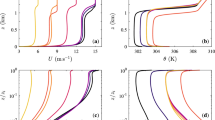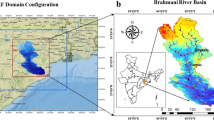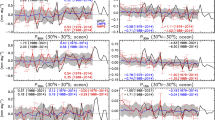Abstract
We investigate the effect of the assimilation of surface and boundary-layer mass-field observations on the planetary boundary layer (PBL) within a one-dimensional (1D) version of the non-hydrostatic Fifth-Generation Pennsylvania State University/National Center for Atmospheric Research Mesoscale Model (MM5). We focus on the vertical extent and effects of mass-field nudging within the PBL based on surface observations, and the added value of assimilating column mass observations within the PBL. Model experiments for dynamic initialization and dynamic analysis are conducted and composited for 29 May, 6 June, and 7 June 2002 during the International H2O Project (IHOP) over the Southern Great Plains, U.S.A. Advantages are found when the data assimilation uses the innovation (the difference between the modelled value and the observed value) calculated by comparing the surface mass-field observation to the model value at the 2-m observation height rather than at the lowest model level. It is shown that this innovation can be applied throughout the model-diagnosed PBL via nudging during free-convective conditions because of the well-mixed nature of the PBL. However, in stable conditions, due to decreased vertical mixing the surface innovation may be best applied only in a shallow layer adjacent to the surface. Surface air-temperature innovations were also applied to the top soil-layer temperature to minimize disruption to the surface energy balance. In combination with the surface observations, the use of within-PBL mass-field data assimilation improves the simulated PBL structure.
Similar content being viewed by others
References
Alapaty K, Seaman NL, Niyogi DS, Hanna AF (2001) Assimilating surface data to improve the accuracy of atmospheric boundary layer simulations. J Appl Meteorol 40: 2068–2082
Alapaty K, Niyogi D, Chen F, Pyle P, Chandrasekar A, Seaman N (2008) Development of the flux-adjusting surface data assimilation system for mesoscale models. J Appl Meteorol Clim 47: 2331–2350
Ardao-Berdejo J, Stauffer DR (1996) On the relative contribution of the Newtonian relaxation term in a non-hydrostatic mesoscale model used for dynamic analysis. In: 11th AMS conference on numerical weather prediction, Norfolk, Virginia, USA, pp 200–202
Belair S, Crevier L-P, Mailhot J, Bilodeau B, Delage Y (2003) Operational implementation of the ISBA land surface scheme in the Canadian regional weather forecast model. Part I: Warm season results. J Hydrometeorol 4: 352–370
Benjamin SG, Weygandt SS, Devenyi D, Brown JM, Manikin G, Smith TL, Smirnova TG (2004) Improved moisture and PBL initialization in the RUC using METAR data. In: 22nd conference on severe local storms, Hyannis, MA, 17.3
Benjamin, SG, Jamison BD, Moninger WR, Sahm SR, Schwartz BE, Schlatter TW (2010) Relative short-range forecast impact from aircraft, profiler, rawinsonde, VAD, GPS-PW, METAR and mesonet observations via the RUC hourly assimilation cycle. Mon Weather Rev. doi:10.1175/2009MWR3097.1
Berg LK, Zhong S (2005) Sensitivity of MM5-simulated boundary layer characteristics to turbulence parameterizations. J Appl Meteorol 44: 1467–1483
Chen F, Dudhia J (2001) Coupling an advanced land surface—hydrology model with the Penn State—NCAR MM5 modeling system. Part I: Model implementation and sensitivity. Mon Weather Rev 129: 569–585
Chen F, Mitchell K, Schaake J, Xue Y, Pan H-L, Koren V, Duan QY, Ek M, Betts A (1996) Modeling of land surface evaporation by four schemes and comparison with FIFE observations. J Geophys Res 101(D3): 7251–7268
Chen F, Manning KW, Yates DN, LeMone MA, Trier SB, Cuenca R, Niyogi D (2004) Development of high resolution land data assimilation system and its application to WRF. In: Preprints of the 20th conference on weather analysis and forecasting/16th conference on numerical weather prediction, Seattle, Washington, USA, 22.3
Chen F, Manning KW, LeMone MA, Trier SB, Alfieri JG, Roberts R, Tewari M, Niyogi D, Horst TW, Oncley SP, Basara JB, Blanken PD (2007) Description and evaluation of the characteristics of the NCAR high-resolution land data assimilation system. J Appl Meteorol Clim 46: 694–713
Childs PP, Qureshi AL, Raman S, Alapaty K, Ellis R, Boyles R, Niyogi D (2006) Simulation of convective initiation during IHOP_2002 using the flux-adjusting surface data assimilation system (FASDAS). Mon Weather Rev 134: 134–148
Coiffier J, Ernie Y, Geleyn J-F, Clochard J, Hoffman J, Dupont F (1987) The operational hemispheric model at the French Meteorological Service. In: Collection of papers presented at the WMO/IUGG NWP symposium, Tokyo, Japan, 4–8 August 1986, 337–345, 831 pp
Deardorff JW (1978) Efficient prediction of ground surface temperature and moisture, with inclusion of a layer of vegetation. J Geophys Res 83: 1889–1903
Deng A (1999) A shallow-convection parameterization scheme for mesoscale models. Ph.D. dissertation, Department of Meteorology, The Pennsylvania State University, 152pp
Deng A, Stauffer DR (2006) On improving 4-km mesoscale model simulations. J Appl Meteorol Clim 45: 361–381
Deng A, Seaman NL, Kain JS (2003) A shallow-convection parameterization for mesoscale models. Part I: Submodel description and preliminary applications. J Atmos Sci 60: 34–56
Deng A, Stauffer DR, Gaudet BJ, Dudhia J, Hacker J, Bruyere C, Wu W, Vandenberghe F, Liu F, Bourgeois A (2009) Update on WRF-ARW end-to-end multi-scale FDDA system. In: 10th annual WRF users’ workshop, Boulder, CO, USA, NCAR, 1.9. http://www.mmm.ucar.edu/wrf/users/workshops/WS2009/WorkshopPapers.htm
Dudhia J (1993) A nonhydrostatic version of the Penn State—NCAR mesoscale model: validation tests and simulation of an Atlantic cyclone and cold front. Mon Weather Rev 121: 1493–1513
Ek MB, Mitchell KE, Lin Y, Rogers E, Grunmann P, Koren V, Gayno G, Tarpley JD (2003) Implementation of Noah land surface model advances in the National Centers for Environmental Prediction operational mesoscale eta model. J Geophys Res 108: 8851. doi:10.1029/2002JD003296
Fast JD (1995) Mesoscale modeling and four-dimensional data assimilation in areas of highly complex terrain. J Appl Meteorol 34: 2762–2782
Gallus WA Jr, Segal M (2001) Impact of improved initialization of mesoscale features on convective system rainfall in 10-km Eta simulations. Weather Forecast 16: 680–696
Garratt JR, Wyngaard JC, Francey RJ (1982) Winds in the atmospheric boundary layer—prediction and observation. J Atmos Sci 39: 1307–1316
Giard D, Bazile E (2000) Implementation of a new assimilation scheme for soil and surface variables in a global NWP model. Mon Weather Rev 128: 997–1015
Grell GA, Dudhia J, Stauffer DR (1995) A description of the fifth-generation Penn State/NCAR mesoscale model (MM5), NCAR Tech. Note NCAR/TN-398+STR, National Center for Atmospheric Sciences, Boulder, CO, USA, 122 pp
Hacker JP, Roskier-Edelstein D (2007) PBL state estimation with surface observations, a column model, and an ensemble filter. Mon Weather Rev 135: 2958–2972
Hayden CM (1973) Experiments in the four-dimensional assimilation of Nimbus 4 SIRS data. J Appl Meteorol 12: 425–436
Holt TR, Niyogi D, Chen F, Manning K, LeMone MA, Qureshi A (2006) Effect of land–atmosphere interactions on the IHOP 24–25 May 2002 convection case. Mon Weather Rev 134: 113–133
Hong S-Y, Pan H-L (1996) Nonlocal boundary layer vertical diffusion in a medium-range forecast model. Mon Weather Rev 124: 2322–2339
Huete A, Didan K, Miura T, Rodriquez EP, Gao X, Ferreira LG (2002) Overview of the radiometric and biophysical performance of the MODIS vegetation indices. Remote Sens Environ 83: 195–213
Janjić ZI (2001) Nonsingular implementation of the Mellor–Yamada level 2.5 scheme in the NCEP Meso model, NCEP Office Note 437, 61 pp. http://www.emc.ncep.noaa.gov/officenotes/FullTOC.html
Lei L, Stauffer DR (2009) A hybrid ensemble Kalman filter approach to data assimilation in a two- dimensional shallow water model. In: 23rd conference on weather analysis and forecasting/19th conference on numerical weather prediction, Omaha, NE, USA
Leidner SM, Stauffer DR, Seaman NL (2001) Improving short-term numerical weather prediction in the California coastal zone by dynamic initialization of the marine boundary layer. Mon Weather Rev 129: 275–294
LeMone MA, Chen F, Alfieri JG, Cuenca RH, Hagimoto Y, Blanken P, Niyogi D, Kang S, Davis K, Grossman RL (2007) NCAR/CU surface, soil, and vegetation observations during the International H2O Project 2002 field campaign. Bull Am Meteorol Soc 88: 65–81
Liu Y, Bourgeois A, Warner T, Swerdlin S, Hacker J (2005) Implementation of observation-nudging based FDDA into WRF for supporting ATEC test operations. In: Preprints, 6th WRF/15th MM5 users’ workshop, Boulder, CO, USA, NCAR, 10.7. http://www.mmm.ucar.edu/wrf/users/workshops/WS2005/WorkshopPapers.htm
Liu Y, Chen F, Warner T, Basara J (2006) Verification of a mesoscale data-assimilation and forecasting system for the Oklahoma City area during the Joint Urban 2003 field project. J Appl Meteorol Clim 45: 912–929
Liu Y, Warner TT, Bowers JF, Carson LP, Chen F, Clough CA, Davis CA, Egeland CH, Halvorson SF, Huck TW, Lachapelle L, Malone RE, Rife DL, Sheu RS, Swerdlin SP, Weingarten DS (2008) The operational mesogamma-scale analysis and forecast system of the U.S. Army Test and Evaluation Command. Part I: Overview of the modeling system, the forecast products, and how the products are used. J Appl Meteorol 47: 1077–1092
MacPherson B, Wright BJ, Hand WH, Maycock AJ (1996) The impact of MOPS moisture data in the U.K. Meteorological Office mesoscale data assimilation scheme. Mon Weather Rev 124: 1746–1766
Michelson SA, Seaman NL (2000) Assimilation of NEXRAD-VAD winds in summertime meteorological simulations over the northeastern United States. J Appl Meteorol 39: 367–383
Mlawer EJ, Taubman SJ, Brown PD, Iacono MJ, Clough SA (1997) Radiative transfer for inhomogeneous atmospheres: RRTM, a validated correlated-k model for the longwave. J Geophys Res 102(D14): 16663–16682
Muñoz RC (2002) Development and testing of physical sub-grid parameterizations for the study of shallow convection interactions over land. Ph.D. dissertation, Department of Meteorology, The Pennsylvania State University, 276 pp
Otte TL (2008) The impact of nudging in the meteorological model for retrospective air quality simulations. Part I: Evaluation against national observation networks. J Appl Meteorol Clim 47: 1853–1867
Otte TL, Seaman NL, Stauffer DR (2001) A heuristic study on the importance of anisotropic error distributions in data assimilation. Mon Weather Rev 129: 766–783
Pleim JE, Gilliam R (2009) An indirect data assimilation scheme for deep soil temperature in the Pleim–Xiu land surface model. J Appl Meteorol Clim 48: 1362–1376
Pleim JE, Xiu A (2003) Development of a land surface model. Part II: Data assimilation. J Appl Meteorol 42: 1811–1822
Reen BP (2007) Data assimilation strategies and land-surface heterogeneity effects in the planetary boundary layer. Ph.D. dissertation, The Pennsylvania State University, 246 pp. http://etda.libraries.psu.edu
Reen BP, Stauffer DR, Davis KJ, Desai AR (2006) A case study on the effects of heterogeneous soil moisture on mesoscale boundary-layer structure in the Southern Great Plains, U.S.A. Part II: mesoscale modelling. Boundary-Layer Meteorol 120: 275–314
Ruggiero FH, Sashegyi KD, Madala RV, Raman S (1996) The use of surface observations in four-dimensional data assimilation using a mesoscale model. Mon Weather Rev 124: 1018–1033
Ruggiero FH, Modica GD, Lipton AE (2000) Assimilation of satellite imager data and surface observations to improve analysis of circulations forced by cloud shading contrasts. Mon Weather Rev 128: 434–448
Schroeder AJ, Stauffer DR, Seaman NL, Deng A, Gibbs AM, Hunter GK, Young GS (2006) An automated high-resolution, rapidly relocatable meteorological nowcasting and prediction system. Mon Weather Rev 134: 1237–1265
Seaman NL (2000) Meteorological modeling for air-quality assessments. Atmos Environ 34: 2231–2259
Seaman NL, Stauffer DR, Lario-Gibbs AM (1995) A multiscale four-dimensional data assimilation system applied in the San Joaquin Valley during SARMAP. Part I: Modeling design and basic performance characteristics. J Appl Meteorol 34: 1739–1761
Shafran PC, Seaman NL, Gayno GA (2000) Evaluation of numerical predictions of boundary layer structure during the Lake Michigan Ozone Study. J Appl Meteorol 39: 412–426
Skamarock WC, Klemp JB, Dudhia J, Gill DO, Barker DM, Duda MG, Huang X-Y, Wang W, Powers JG (2008) A description of the advanced research WRF version 3, NCAR Tech. Note NCAR/TN-475+STR, National Center for Atmospheric Research, Boulder, CO, USA, 125 pp
Stauffer DR, Seaman NL (1990) Use of four-dimensional data assimilation in a limited-area mesoscale model. Part I: Experiments with synoptic-scale data. Mon Weather Rev 118: 1250–1277
Stauffer DR, Seaman NL (1994) Multiscale four-dimensional data assimilation. J Appl Meteorol 33: 416–434
Stauffer DR, Seaman NL, Binkowski FS (1991) Use of four-dimensional data assimilation in a limited-area mesoscale model. Part II: Effects of data assimilation within the planetary boundary layer. Mon Weather Rev 119: 734–754
Stauffer DR, Muñoz RC, Seaman NL (1999) In-cloud turbulence and explicit microphysics in the MM5. In: Proceedings ninth PSU/NCAR MM5 model users’ workshop, Boulder, CO, USA, NCAR, pp 177–180
Weckwerth TM, Parsons DB, Koch SE, Moore JA, LeMone MA, Demoz BB, Flamant C, Geerts B, Wang J, Feltz WF (2004) An overview of the International H2O Project (IHOP_2002) and some preliminary highlights. Bull Am Meteorol Soc 85: 253–277
Zhang D, Anthes RA (1982) A high-resolution model of the planetary boundary layer—sensitivity tests and comparisons with SESAME-79 data. J Appl Meteorol 21: 1594–1609
Zilitinkevich SS (1995) Non-local turbulent transport: pollution dispersion aspects of coherent structure of convective flows. In: Power H, Moussiopoulos N, Brebbia CA (eds) Air pollution III—vol. 1 Air pollution theory and simulation. Computational Mechanics Publications, Boston, 53–60, 456 pp
Author information
Authors and Affiliations
Corresponding author
Rights and permissions
About this article
Cite this article
Reen, B.P., Stauffer, D.R. Data Assimilation Strategies in the Planetary Boundary Layer. Boundary-Layer Meteorol 137, 237–269 (2010). https://doi.org/10.1007/s10546-010-9528-6
Received:
Accepted:
Published:
Issue Date:
DOI: https://doi.org/10.1007/s10546-010-9528-6




